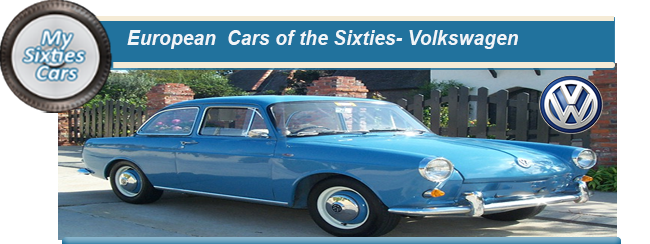
World War Two had a far-reaching impact on the history of all European car manufacturers – and none more so than Volkswagen.
Volkswagen, as a company is unique in the fact that its very creation, was a political initiative, rather than to fulfil the dreams and aspirations of an ambitious business person of a gifted engineer with a desire to carve out a niche in the car industry of the Twentieth century.
Founded only in 1936 by a political organisation known as the Deutsche Arbeitsfront (German Labour Front ) Volkswagen was the fruit of the tainted vision of Adolf Hitler, who, in one of his better-intentioned initiatives, wanted to bring car ownership within reach of the “ working class.”
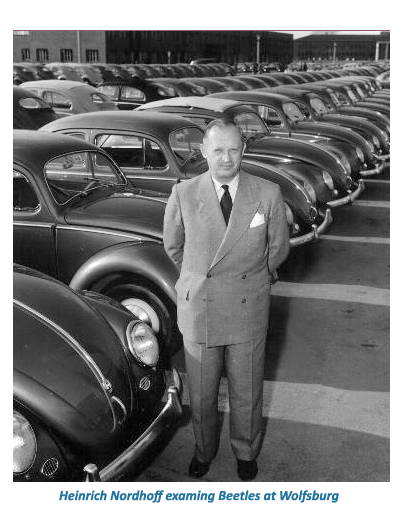
The reason might have been that most of the vehicles on German roads in the Twenties and Thirties were indeed large, luxurious and very expensive.
Hitler wanted to create a “Volkswagen” – which literarily translates to “ people's car” and was prepared to bring in the most talented people in the German automotive industry to make his vision a reality.
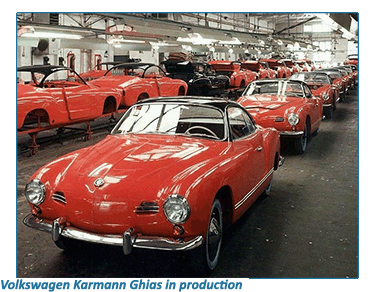 Before the Volkswagen was developed, there were a number of German carmakers who produced compact cars, although none came nowhere near creating the impact of the Beetle.
Before the Volkswagen was developed, there were a number of German carmakers who produced compact cars, although none came nowhere near creating the impact of the Beetle.
The first step in getting the people’s car project off the ground was an approach to Dr, Ferdinand Porsche, one of Germany’s top auto designers, who, as an independent, had worked for most of the country’s top car manufacturers.
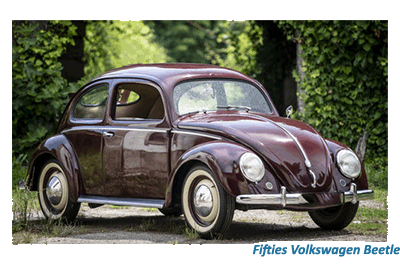 Dr Porsche was known to be interested in designing a compact family car but had found no takers among his usual clients.
Dr Porsche was known to be interested in designing a compact family car but had found no takers among his usual clients.
During the early Thirties, Porsche had created a working prototype of an air-cooled rear engine Volkswagen, whose exterior design was based on a "beetle" shape, which Porsche was confident would reduce the cost of running the car considerably thanks to dramatically improved aerodynamics.
Dr Porsche soon concluded that none of the existing German car plants had the desire or ability to produce a “Volkswagen” and the only way was to establish a facility that would be custom designed just to build this particular model.
![]()
With the Third Reich giving their full approval and unlimited financial backing, Dr Porsche and his team began to examine possible locations for the new plant.
They eventually decided on a small town, Fallersleben, adjacent to the city of Wolfsburg, in the Lower Saxony region of Northern Germany. By the time production was ready to gt underway, Porsche and his team had already established that the Volkswagen project could never be financially viable. It appears that neither Dr Porsche nor any of his management team were prepared to bring that piece of news to Hitler, so the project went ahead.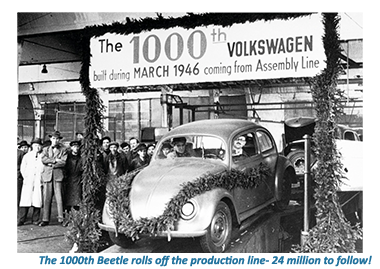 Many thousands of these so-called “prototypes” were believed to have been produced in the late Thirties and early- Forties.
Just when the Wolfsburg plant was about ready to begin marketing the Beetle to the German public, Germany’s increasing involvement in World War Two meant that the plant’s facilities had to be turned over for the war effort.
During the war, as the Allied forces became aware that Volkswagen was wholly involved in production for the German Army, air attacks on the Wolfsburg plant grew in intensity.
When the armistice agreement was signed in 1945, Germany, or West Germany, was in ruins.
Dr Frederick Porsche washed his hands of Volkswagen and went off to design and produce his own brand of cars and wanted nothing more to do with the Beetle.
Many thousands of these so-called “prototypes” were believed to have been produced in the late Thirties and early- Forties.
Just when the Wolfsburg plant was about ready to begin marketing the Beetle to the German public, Germany’s increasing involvement in World War Two meant that the plant’s facilities had to be turned over for the war effort.
During the war, as the Allied forces became aware that Volkswagen was wholly involved in production for the German Army, air attacks on the Wolfsburg plant grew in intensity.
When the armistice agreement was signed in 1945, Germany, or West Germany, was in ruins.
Dr Frederick Porsche washed his hands of Volkswagen and went off to design and produce his own brand of cars and wanted nothing more to do with the Beetle.
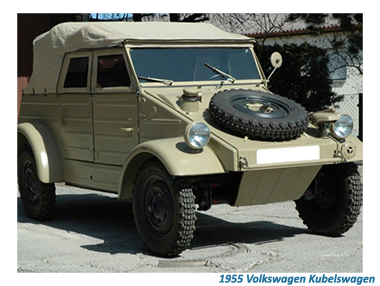 That was until Major Ivan Hirst of the British Army appeared on the scene.
As fate would have it, it was Hirst, who was handed the responsibility of running the Wolfsburg plant after it was captured by Allied forces just a few weeks before the end of the war.
Members of the occupation forces charged with the responsibility of salvaging what they could, would have made minimum effort to save the plant, instead rapidly selling off any valuable pieces of production equipment as well as raw materials for the highest price to pay for war repatriations.
That was until Major Ivan Hirst of the British Army appeared on the scene.
As fate would have it, it was Hirst, who was handed the responsibility of running the Wolfsburg plant after it was captured by Allied forces just a few weeks before the end of the war.
Members of the occupation forces charged with the responsibility of salvaging what they could, would have made minimum effort to save the plant, instead rapidly selling off any valuable pieces of production equipment as well as raw materials for the highest price to pay for war repatriations.
 Hurst, a no-nonsense engineer from the city of Oldham in North-Western England, saw the potential in the plant, but ironically not in the Beetle, but instead in the Kübelwagen, which he thought could have some use for occupation troops in the coming years.
Anxious to help the local population, who were badly in need of income to feed themselves and their families, Hurst convinced the Allied administration to order 20,000 all-purpose Kübelwagen which would have guaranteed the future of the plant for a number of years.
Hurst, a no-nonsense engineer from the city of Oldham in North-Western England, saw the potential in the plant, but ironically not in the Beetle, but instead in the Kübelwagen, which he thought could have some use for occupation troops in the coming years.
Anxious to help the local population, who were badly in need of income to feed themselves and their families, Hurst convinced the Allied administration to order 20,000 all-purpose Kübelwagen which would have guaranteed the future of the plant for a number of years.
![]()
With little knowledge of German and even less of the lie of the land in and around Wolfsburg, Major Hirst once again displayed his considerable common sense by employing Heinrich Nordhoff to act as production manager and liason for the plant.
Nordhoff, then in his mid-Forties, had a wealth of experience in the car industry in Germany, working for BMW before the war and in the immediate post-war years as an advisor for the occupation forces.
The unlikely combination of Hirst and Nordhoff proved to be a highly productive one, with the pair working together to solve the day to day problems of the plant, in particular, the chronic shortage of raw materials and the low level of moral and health of the production staff.
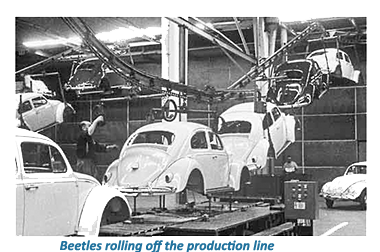 Despite these difficulties, the Volkswagen factory, as it was now known, looked like it could be a viable business, especially as the public had caught on to the compact car concept and demand for the Beetle was steadily on the rise.
Despite these difficulties, the Volkswagen factory, as it was now known, looked like it could be a viable business, especially as the public had caught on to the compact car concept and demand for the Beetle was steadily on the rise.
Eventually, to Hirst and Nordhoff’s credit,the duo reached the conclusion that the potential was so large that it was too hot for them to handle on their own.
Feelers were sent out to the major influences in the car industry, especially those based in the United States, but no serious buyers were found.
With Ivan Hirst due to return to the UK in 1949, once again the future of Volkswagen was looking doubtful.
At the very last minute, the West German government stepped in, having put together a rescue plan in conjunction with the government of the State of Lower Saxony, investing the minimum of capital to do so.
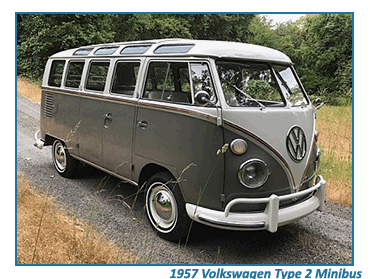 Nordhoff did a remarkable job in keeping Volkswagen afloat but became the subject of increasing criticism for his reluctance in expanding the range of vehicles produced at Wolfsburg.
Nordhoff did a remarkable job in keeping Volkswagen afloat but became the subject of increasing criticism for his reluctance in expanding the range of vehicles produced at Wolfsburg.
During his tenure, Nordhoff was responsible for the release of just two vehicles to the Volkswagen range, one of them the iconic Type 2 van ( also available as a pickup and camper), and the other the Karman Ghia sports car, which even went on to become an icon in its own right.
During the Sixties and onwards, Volkswagen continued to consolidate and even expand their sales and global reach.
Determined to be thought off as a company who had more than just three cars to offer, during the Sixties, they increased their ranges considerably with the Type Three and Type Four series, which included their first-ever four-door sedan and estate car.





